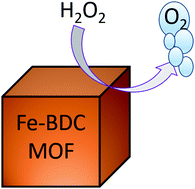Heterogeneous catalytic decomposition of hydrogen peroxide utilizing a Fe(iii)-based metal–organic framework as an efficient and persistent nanozyme
Abstract
Catalases exert their crucial role in protecting living cells from damage caused by reactive oxygen species (ROS) through effectively catalyzing hydrogen peroxide decomposition to water and oxygen. Despite the fact that naturally occurring enzymes demonstrate unparalleled activity in their natural habitat, they suffer from rapid denaturation and loss of activity under harsh conditions. Thus, it is of great interest to develop an alternative material that demonstrates intrinsic enzyme-like activity mimicking the catalase behavior, but with enhanced structural stability under industrially relevant conditions. Nanomaterials with enzyme-like activity known as “Nanozymes” have been widely used in several catalytic processes. Herein, we demonstrate the superior catalytic activity of a Fe-based metal organic framework known as MIL-53(Fe) as a cheap nanozyme generated through a facile solvothermal synthesis to catalytically mediate the H2O2 decomposition. The data shows that the MOF demonstrated exceptional rapid catalytic activity towards H2O2 decomposition without applying any heat, additionally with high recyclability without significant loss in activity for an extended number of cycles.



 Please wait while we load your content...
Please wait while we load your content...